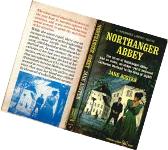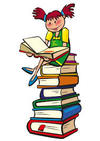
Or...
Maybe, as some authors claim, it's because the cover blurb is one of your book's most important selling factors (along with the cover).

Answer: P.D.H. Pretty darn hard.
I found several different approaches to writing the all-important blurb. Some authors focus on process, others on content. All focus on the importance and choice of words. And they all overlap to one extent or another. Who knew?
PROCESS
By process I mean the steps you go through to writing the cover copy: where you start and how you approach it.
● Read other blurbs in the same genre
Nothing will give you better insight than to read other book blurbs, particularly in the genre of your novel.

If the book is a comedy, was this obvious in the way the blurb was written? If the book was dark, could you tell? Could using the distinctive voice of the narrator have improved the blurb?
Second, study the blurbs for books you've read and analyze how well the copy writer has condensed the content and hit the major points, as well as answering the other questions above.

• What's the overarching question/conflict in my book?
• If readers take away just one thing from this book, what do I want it to be?
• What's special about my plot? Why is this book different from any others?
You need to be able to articulate the answers to these questions, not just for the blurb but because they are paramount to your pitches and other promo materials. Besides, if you still don't know after finishing the book, perhaps you should reconsider publishing it.

A shoutline is bolded text at the start of a blurb, or between paragraphs, that grab readers' attention and entice them to read on. Good shoutlines are unique, short, and convey at least one hook to the story. I consider a shoutline equivalent to a tagline. Whether or not you use it in the cover copy, you'll need to write a tagline.
● Use lines from the manuscript
This gives the reader the flavor of the book and the author's voice. Amy Wilkins, copy writer for Harlequin, says she reads the first 15 pages of a book and highlights passages of the manuscript that are suitable for the cover copy. She uses this example from The Hollow House by Janis Patterson.
“I decided to use the name Geraldine Brunton. It’s not the name I was born with, nor the name
I married, but it will hide who I really am…and what I have done.”
Ms. Wilkins indicates that the text is "almost straight from the book, with some tightening. It’s perfect for copy because it sets up so much: the protagonist’s name, the fact that she’s under disguise, and she’s done something in her past she has to run from. It also conveys the voice and the fact that the book is written first person."

You don't want too much plot. Write down the key points the reader needs to know about the book. Be tough with yourself. Don't try to explain the twists and turns. Write a hook that captures the interest of the reader. Check for spoilers. Are you telling the whole plot, including how the conflict or problem is resolved?
No, no, no!

Write an ending hook. Amy Wilkins also points out that the blurb should leave the reader -- or agent, or acquiring editor -- wanting more. "The last line should leave them dying to read the book to learn how the story ends, and the best way to do this is by beefing up the conflict in your final line." There are few different ways to hook your readers:

“What will Adam do when he discovers Florentina’s deception?” – A Scandalous Proposition
▪ Hint at future danger
“When their investigation leads them to a city hall conspiracy, both their lives and their newly reignited flame could be permanently extinguished…” – Risking Trust

“But amidst rival reporters, eager fanboys and overzealous role-players, it’s Emma’s secret that may put the brakes on their sizzling attraction for good…” –Defying Convention
Resist the urge to hint at how things will work out—editors and agents will find that out in the synopses and readers will find out by reading the book!"
● Edit, Edit, Edit!
There's nothing worse than cover copy with errors. Your blurb should be clean, short, error free, and screened for spoilers. No matter what, do not give away the resolution. This is not a synopsis. Have others read the blurb and comment; use your critique group or partner, find another pair of eyes.
CONTENT
This is what to include in your three to four paragraphs. Yes, I do mean three to four.

Whether or not you choose a shoutline or a few sentences from the opening of the book, the first sentence needs to grab the reader's attention. This is the big idea of the book.
● A hint of the plot
The premise, the initial action, the inciting incident.
● A hint of setting and time
The reader needs to know where and when the story takes place, but remember that your book is about people. Don't emphasize setting over your characters.
● Name and characterize main characters, including the antagonist.
● Goals or what the main character(s) wants
Include the stakes or a ticking time-bomb. Urgency. Show that something can be lost.
● Central conflict and end Hook
Who is keeping the main character from getting what he/she wants? Hint at a question to be answered or a mystery to be solved that draws in the reader. In establishing the conflict, hint at what could happen. Here's where the question or hint of future danger and the stakes comes in. While some authors suggest that the blurb should end with a hint at resolution, it's critical not to give away too much. At all costs, avoid spoilers. Leave the reader wanting more.
I particularly like Marilynn Byerly's article on this subject because she makes differentiations between genres in a way that made sense to me. She addresses romance, romantic suspense, mystery or suspense, science fiction and fantasy.[http://www.marilynnbyerly.com/blurb.html.] Here is what she says about romantic suspense. "If some important point fits one paragraph better than another, don't feel as if you must follow my structure. Put it where it fits."
First paragraph:
Simple plot set up, and main character's emotional involvement with it. What is the exterior conflict of the novel? (What are the hero and heroine fighting against and why?) The examples are from my THE GAME WE PLAY.
"Schoolteacher Faith Cody thinks she has the perfect summer job as nanny to Nicholas Price's two
visiting children, but the children are kidnapped, and she and Nick are compelled to join forces to
steal the ransom documents incriminating vicious criminals."
Second paragraph:
More simple plot set up and hero's or second lead's emotional involvement with it.
"An investigative journalist trained in the ways of the professional cat burglar, Nick has the skill to
steal the hidden documents, but their dangerous owner guards the documents well since they
prevent his death."
Third and Fourth paragraphs:
What is the interior conflict of the novel? (What tears the hero and heroine apart emotionally?) What must both must achieve or defeat and what do they have to lose? This can include plot set up, place set up, the important secondary characters, and the villain.
"At the secluded estate of their intended victim, on the catwalks above a Las Vegas stage, and in a
back alley at the mercy of killers, Faith and Nick face danger with a witty quip and a willingness to
risk anything and anyone, even each other, for the sake of two children they both love.In this game of
betrayer and betrayed, the kidnappers seem determined to destroy Nick's sanity as well as his life,
and Faith's life and love may be their ultimate weapon against him."
Here's a different blurb which focuses on my hero. It's more suspense than romantic suspense.
"The prize: His two kidnapped children
The rules: Trust no one, betray anyone, win at whatever the cost
His pawns: His lover and his best friend
His opponent: The most dangerous catburglar in history
The game: A game of betrayal, THE GAME WE PLAY".
CHOICE OF WORDS
It's not too difficult to understand why choice of words is important. Each one has to convey information to the reader in a clear and enticing manner. You should use the same techniques as writing a logline or tagline. You're shooting for effect, and it's not an easy task, but here are some hints to make your words count.
● Use words that evoke images and resonate with readers of the genre
It is important to know your audience, the terms and buzz words they use (or abbreviations for people who text a lot), and the images and references they understand. Ideally, that's the way your novel is written too. Imagery is very important. You can set the stage by using a word or two that your audience can envision.

For example, instead of describing the main character as "a detective", use "a cynical fifty-year-old detective" or "a young, enthusiastic detective."

But don't get carried away with adjectives. You don't want your blurb to sound flowery and overenthusiastic.
● Use hyperbole
This is deliberate and obvious exaggeration or overstatement used for effect, e.g. "I could eat a million of these."
● Use extreme action verbs
Providers of book blurbs like to promote literature with words like "sizzling", "crackling" or "shattering".
● Use bright, compelling language
Since the purpose of a blurb is to promote your novel, write passionately about it. The question your reader will have is "Why should I read this?" Give them a convincing reason to do so.
● Stay away from clichés
Need I say more? Write a thoughtful description without resorting to other people's wording. Avoid schmoozy hype and over-blown descriptors, such as amazing, life-changing, incredible’ etc.
● Use keywords where appropriate
Keywords are words people use with search engines to find things on the Internet. There are certain words which will get better results than others when consumers are looking for offerings like yours.
I can understand using keywords as tags on Amazon and Barnes & Noble (although I don't believe people look for books this way), but I can't see the point in a cover blurb. Still, some authors recommend the use of keywords when they fit, so I'm passing that on.
CONCLUSION
To reiterate, your cover blurb is one of your books most important selling factors and will probably determine whether or not readers select your book over other choices. It is an invitation for readers to step into your book and is worthy of your best thinking, insight, and writing.

So, as much as you may dislike doing it, take the time to read other cover blurbs and analyze them. Analyze your own novel with the most critical eye you've ever used. Ask for other opinions and listen to the comments, do your homework, and employ your best writing skills. You'll be pleased with the results.
AFTERWORD
After you've done the research and written the cover blurb for your completed novel, try this. Take a shot at writing the cover blurb for the novel you are working on. It will force you to focus on the big idea and the key points for the novel you intend to write. Every now and then, update it without making it longer. You'll be surprised how useful this will be for keeping yourself on track, and when you finish, your blurb will already be written.
Please share your thoughts and, also, the worst and blurbs you've ever read.
□
Resources
http://www.bpsbooks.com/BPS-Books-blog/bid/24819/Writing-Tip-How-to-Write-a-Winning-Blurb
http://www.angelascottauthor.com/2/post/2013/04/are-you-having-a-difficult-time-writing-a-book-blurb-youre-not-alone.html
http://www.lightmessages.com/lmjom/writing/229-how-to-write-a-book-cover-blurb.html
http://www.bpsbooks.com/BPS-Books-blog/bid/24819/Writing-Tip-How-to-Write-a-Winning-Blurb
http://www.ehow.com/how_2074207_write-book-blurb.html
http://blog.emilysuess.com/better-book-blurb-copywriting-for-fiction/
http://www.marilynnbyerly.com/blurb.html
http://spiritauthors.com/news/how-to-write-good-blurbs-and-back-pages-for-your-book/
 RSS Feed
RSS Feed